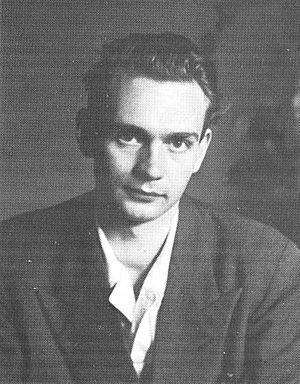Stig Dagerman facts for kids
Quick facts for kids
Stig Dagerman
|
|
|---|---|

Stig Dagerman, 1940s
|
|
| Born | Stig Halvard Andersson 5 October 1923 Älvkarleby, Uppsala County, Sweden |
| Died | 4 November 1954 (aged 31) Enebyberg, Stockholm County, Sweden |
| Occupation | Writer, journalist |
| Language | Swedish |
| Nationality | Swedish |
| Years active | 1945–1954 |
Stig Halvard Dagerman (born October 5, 1923 – died November 4, 1954) was an important Swedish writer and journalist. He became well-known right after World War II.
Contents
About Stig Dagerman
Stig Dagerman was born Stig Halvard Andersson in Älvkarleby, Sweden. He later changed his name to Stig Dagerman when he was a teenager.
His Writing Career
In just five years, from 1945 to 1949, Stig Dagerman wrote a lot. He published four novels, a collection of short stories, and a book about Germany after the war. He also wrote five plays, many poems, and essays. He was a very busy journalist too. Sadly, he passed away in 1954.
His Writing Style
Stig Dagerman was part of a Swedish writing movement called fyrtiotalism. This style often explored serious and deep feelings. His stories often talked about fear, guilt, and loneliness.
Themes in His Work
Even with these serious topics, Dagerman also showed a funny side. His writing sometimes became playful or even satirical. He used humor to make his points.
His Legacy
Stig Dagerman's work continues to be important today. The annual Stig Dagerman Prize is given to people who, like him, help others understand each other. This award celebrates empathy and understanding.
Main Books and Plays
Here are some of Stig Dagerman's most famous works:
- Ormen (The Snake) 1945, a novel
- De dömdas ö (The Island of the Doomed) 1946, a novel
- Tysk höst (German Autumn), 1947, a non-fiction book about post-war Germany
- Nattens lekar (The Games of Night) 1947, a collection of short stories
- Bränt barn (A Burnt Child) 1948, a novel
- Dramer om dömda: Den dödsdömde; Skuggan av Mart (Dramas of the Condemned: The Man Condemned to Death; Marty's Shadow) 1948, plays
- Judas Dramer: Streber; Ingen går fri (Judas Dramas: No One Goes Free; The Climber) 1949, plays
- Bröllopsbesvär (Wedding Worries) 1949, a novel
- Vårt behov av tröst (Our Need for Consolation is Insatiable) 1955, a collection of prose and poetry
English Translations
Many of Stig Dagerman's works have been translated into English. This allows more people around the world to read his stories.
Translated Books
- German Autumn. Translated by Robin Fulton.
- Sleet - Selected Stories. Translated by Steven Hartman.
- A Burnt Child. Translated by Benjamin Mier-Cruz.
- Island of the Doomed. Translated by Laurie Thompson.
- The Snake. Translated by Laurie Thompson.
- The Games of Night. Translated by Naomi Walford.
- A Moth to a Flame. Translated by Benjamin Miers-Cruz.
Adaptations of His Work
Some of Stig Dagerman's stories have been turned into films or other creative works.
- "To Kill A Child" (2003) a short film directed by Bjorne Larson and Alexander Skarsgard.
- "The Games of Night" (2007) a short film by Dan Levy Dagerman.
- "Our Need for Consolation" (2012) a short film by Dan Levy Dagerman.
- "Notre besoin de consolation est impossible a rassasier," a song by the French band Têtes raides (2007).
- "Stig Dagerman," a French poem by Kentin Jivek, from his album "Now I'm Black Moon" (2011).
See also
 In Spanish: Stig Dagerman para niños
In Spanish: Stig Dagerman para niños

